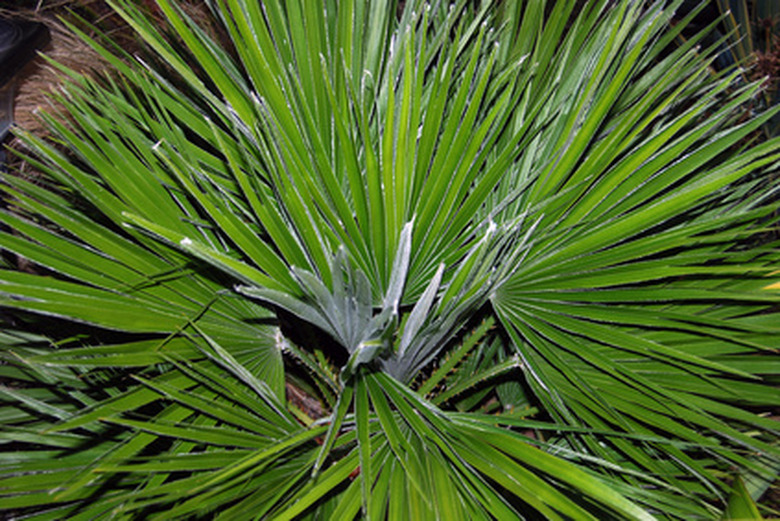How To Care For A Chinese Fan Palm
Things Needed
- Potting soil
- Perlite
- Peat moss
- Thermometer
- Houseplant fertilizer
- Hedge clippers
- Container
Chinese fan palm (Livistona chinensis) produces large, attractive, fan-shaped leaves with fringed tips. Native to southern Japan, China and Taiwan, the plant requires warmth to thrive and cannot survive cold temperatures. In the United States, gardeners grow Chinese fan palm indoors, except in the extreme southern areas of the country. Grown as either a single-stem tree or mutli-stem shrub, Chinese fan palm reaches heights of up to 40 feet in its native habitat, though it typically stays much shorter indoors.
Step 1
Keep Chinese fan palm in a location that receives bright sunlight, such as a south- or west-facing window, and provide well-drained, moist potting soil. For the best results, combine equal parts potting soil, perlite and peat moss to supply adequate drainage and fertility.
Step 2
Maintain a temperature of 60 to 80 degrees F at all times to avoid unnecessary stress on the tree. Keep a thermometer near the plant to ensure the temperature does not leave this range. If temperatures drop too low or rise too high, permanent damage may occur.
- Chinese fan palm (Livistona chinensis) produces large, attractive, fan-shaped leaves with fringed tips.
- Grown as either a single-stem tree or mutli-stem shrub, Chinese fan palm reaches heights of up to 40 feet in its native habitat, though it typically stays much shorter indoors.
Step 3
Water Chinese fan palm when the soil's surface feels dry to the touch, about once every five to six days. Allow the soil to dry out a little more during fall and winter, watering about once every seven to 10 days. Soak the soil thoroughly until water begins to drain from the bottom of the container, wait several minutes and then drain away excess water.
Step 4
Feed the plant once every month during spring and summer using an all-purpose liquid houseplant fertilizer. Water lightly prior to fertilizing to reduce the risk of root burn or injury. Apply according to the instructions provided on the package for the best results. The plant does not require feeding during the fall and winter months.
- Water Chinese fan palm when the soil's surface feels dry to the touch, about once every five to six days.
- Soak the soil thoroughly until water begins to drain from the bottom of the container, wait several minutes and then drain away excess water.
Step 5
Prune Chinese fan palm during late winter, just before new growth begins in spring. Remove any damaged or diseased foliage, and shorten any excessively long growth using hedge clippers. The tree does not typically require excessive pruning, but may need trimming to increase aesthetic appeal.
Step 6
Repot the plant once every two to three years or whenever it outgrows its container. Increase the size of the new container by about 3 inches in diameter and provide a fresh growing medium to reduce the shock of transplanting. Water thoroughly after repotting to firm the soil around the plant's roots and initiate new growth.
Tip
Grow Chinese fan palm outdoors in USDA hardiness zones 9b through 11 only. For the best results, plant in well-drained soil in full sun to light shade, water only when two weeks have passed without natural rainfall, fertilize once every four to six months and apply organic mulch.
Warning
Never allow standing water to accumulate around the plant, as this results in root rot.
References
- "Beyond the Windowsill: Add Style to Your Home with the Beauty of Indoor Plants"; Jon Carloftis; 2007
